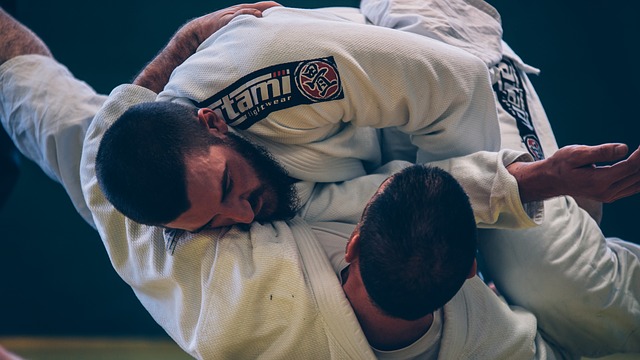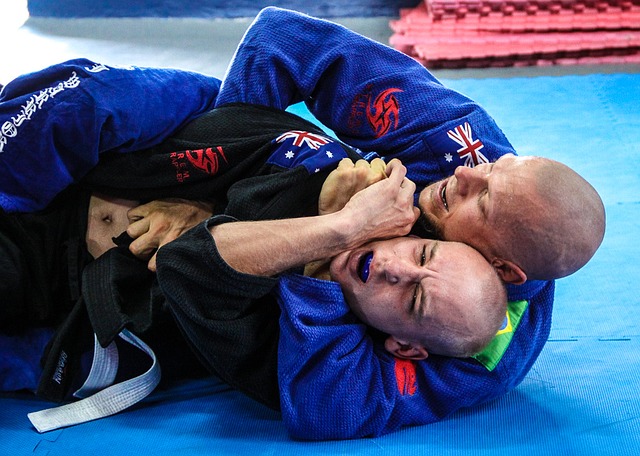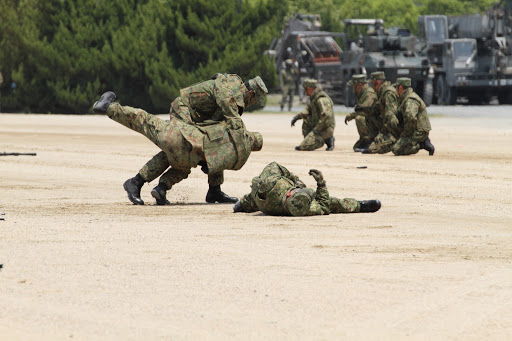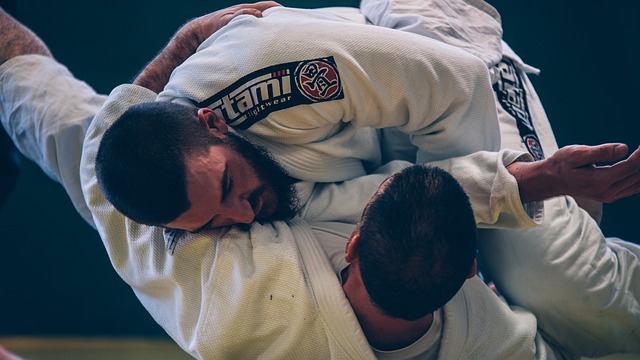
When you’re deciding on a branch of martial arts, there’s nothing wrong with dating back to the most traditional. Going back to the adage, “if it ain’t broke, don’t fix it”. Japanese Jiu-Jitsu is one of earliest martial arts that was practiced and taught. Although most of you might be familiar with Brazilian Jiu-Jitsu, it is much different and has come along with since the original Japanese Jiu-Jitsu.
In this guide, I’m going to tell you not only go into the details behind Jiu-Jitsu, from the Jiu-Jitsu meaning to the Jiu-Jitsu history, I’m going to break down various aspects of the martial arts.
It has come a long way from its origins in Japan, Jiu-Jitsu Japanese modernly is separated into two separate categories. This martial arts is separated into two different categories, Sport Jiu-Jitsu and Self Defense Jiu-Jitsu. Both have their benefits and appeal, one presenting some aspects than the others.
Sport Jiu-Jitsu
This category is seen throughout tournaments, academies, and competitions with students all around the world. In this category, a fighter can win a competition by submission or by points.
Self Defense Jiu-Jitsu

Just as the title suggests, this form of Jiu-Jitsu is focused on self-protection when under attack and is more for protection on the street when one may encounter a fight. With this form, you can end a fight or altercation quickly — it is effective and to the point.
History of Jiu-Jitsu

As I mentioned before, Jiu-Jitsu has a long-winding history dating back to one of the first martial arts organized and practiced. There’s a reason why it became so popularized and modern and is still in practice today: its methods work.
Regardless if you want to practice martial arts to learn self-defense or to compete, later on, it’s important to know where it came from and how it was used in history.
Since it began centuries ago, it isn’t exactly clear how it began or formed, however, there has been much speculation over its origination.
Straight from the practice of Buddhist monks, it has been legend passed down that it was a way that they trained in India when they needed to defend themselves in a peaceful manner. The literal translation of the meaning of Jiu-Jitsu is “peaceful way”. This signifies the fact that those who practice Jiu-Jitsu do so without weapons.
Military Martial Art

Another theory speculated, however also has its proven roots, is the fact that Jiu-Jitsu dated its origins back to samurai soldiers. They had to learn this type of martial arts to be able to be lethal in hand-to-hand combat. This suggests that the original Jiu-Jitsu was much more lethal than what it is today because in some cases, it had to be used to kill. As time went on, it was then modernized and distilled slightly to be used for sport, recreation, and self-defense.
Back in the day, during these military time, it was a mixture of wrestling and bare-handed grappling that turned into submission.
It was not only used overseas, being popular in the U.S. as well. The American military and local law enforcement used black belt Jiu-Jitsu coaches to instruct soldiers and officers to be practiced in self-defense and when it would come down to hand-to-hand combat.
Judo

Another part of Japanese Jiu-Jitsu was Judo. This Japanese school was first formed around 1532 by Hisamori Tenenuchi, which was then evolved into Judo in the 1800s. Judo soon took over to become Japan’s official martial arts and a lot more effective in combat than Jiu-Jitsu. However, although it has become much more popular, there are still some fighters who practice the original Japanese Jiu-Jitsu to this day.
Brazilian Jiu-Jitsu

If I’m talking about Jiu-Jitsu, I can’t not mention Brazilian Jiu-Jitsu, which was taken from the original Japanese Jiu-Jitsu and modernized by the Gracie family. Brazilian Jiu-Jitsu was created more with the smaller fighter in mind at the Gracie Jiu-Jitsu Academy.
Although you might have to search elsewhere for Brazilian Jiu-Jitsu facts, an extensive history of Brazilian Jiu-Jitsu or looking up Brazilian Jiu-Jitsu Youtube, it had a huge role in the success of Jiu-Jitsu.
Other branches also had a huge influence of Jiu-Jitsu, like Muay Thai, Taekwondo, and Karate, you will have to search elsewhere, as well, to find the answers to questions like: what is muay thai, what is taekwondo, what is karate, and other questions you may have.
Which brings us to the still solid reputation and practice of Jiu-Jitsu held today. Those who practice the martial arts branch use throw and locks to defend themselves. Through training for Jiu-Jitsu, one will see a lot of benefits, both mental and physical. Although most of these benefits are also in other martial arts branches, some of them are certainly specific to Jiu-Jitsu.
Benefits of Jiu-Jitsu
Whether you are training Jiu-Jitsu as an avid competition and are looking to enter in competitions or are simply looking for a fun way to stay in shape, here are some benefits of Jiu-Jitsu:
|
Get You in Shape |
If you are looking to get fit, Jiu-Jitsu has extremely rigorous training that is mainly because of the grappling involved, which is an extremely physical move. However, it doesn’t stop there. Jiu-Jitsu is a full-body, all encompassing workout that has cardiovascular training, breathing work, stretching, resistance training, endurance training, strength training, and helps increase your flexibility. |
|
Learn How to Fall |
One of the first things you learn, which, in retrospect, helps you learn in whatever fight or martial arts you might be in, is how to fall. In Jiu-Jitsu, you will learn how to sweep your opponent, trip them, and throw them. You, in turn, will also at one point be victim of all these moves. Therefore, to be able to take practice in fighting Jiu-Jitsu you have to learn how to train and fall without getting injured. So, even if you don’t learn how to beat your opponent, you will at least know how to fall without getting badly injured. |
|
Learn How to Defend Yourself |
From its origins on the battlefield, Jiu-Jitsu is used in hand-to-hand combat, both in attacking and in defending. The moves and Jiu-Jitsu techniques you learn make you highly capable of defending yourself and whoever is near you — if need-be. Although it takes a few years of practice to be considered a master of Jiu-Jitsu, in your first few days you might learn some techniques and skills that can be highly life-saving, as simple as they may be. |
|
Learn the Essences of Patience and Discipline |
Through this martial art, you will learn the importance of these two factors. While fighting, you will learn all about having to be patient, knowing when your timing is right, and finding your rhythm. When you have worked on everything you need to work on, throwing a punch or kick at the right moment should feel effortless. As you develop patience and discipline through Jiu-Jitsu, you will be able to transfer it to other stages in your life, as well. |
|
Fun |
Although training Jiu-Jitsu is exhausting, difficult, and strenuous, filled with various moves and techniques that can make you frustrated, learning this martial art can be fun! Participating in fun activities are not only good for your soul they also eliminate stress. |
Fundamentals Every Beginner in Jiu-Jitsu Should Know

|
1. How to Relax |
Being good in Jiu-Jitsu requires to be calm under pressure. Your ability to be able to relax even when in the most pressing of situations is crucial for your success. If you aren’t able to be calm while you’re fighting and control your head, you’ll overexert yourself, becoming injured, exhausted, and overtrained. In a crucial situation where someone is possibly in danger, most students let their ego get in the way of a successful battle. They will want to win at all costs and with that, they let their head get the best of them. Even if the student knows the skill, if they aren’t relax, they won’t have a cool head to be able to execute those skills. Jiu-Jitsu will make you competitive but it’s good to have your ego in check to know that you probably won’t ever be the best fighter in the world. Therefore, when you’re under pressure situations, you won’t be so concerned in being the best, allowing your skills to take over your ego. Relaxing is mind over matter. Take the time to focus on developing your skills and honing in on learning new techniques. |
|
2. Execute Bridging and Shrimping |
Jiu-Jitsu will almost always have you end up on the ground, grappling. Bridging and Shrimping are crucial moves and techniques that are important in any Jiu-Jitsu match. Not only will learning these techniques be important while you’re training, they will be most important during a match. Doing them correctly time and time again will help you develop the techniques so they almost become second nature to you. Being able to refine your bridge and shrimp are important to your fighting game. For a video on how to bridge and shrimp: https://www.youtube.com/watch?v=CxQjpigJTS8 |
|
3. Learning how to Grip correctly |
Jiu-Jitsu wouldn’t be Jiu-Jitsu without gripping. It is a large component of the game that has three different features to make your fight as strong as possible. The first feature is how strong your hands are. After a bit of training, it’s inevitable that your fingers and hands will become stronger. However, if you’re looking to speed up the process, you can look up grip-strengthening exercises and tools. There also might be other sports that can help you in your Jiu-Jitsu— like rock climbing that works on your grip while having fun. This means that you can train for Jiu-Jitsu without even realizing it. The second feature is to have efficient gripping because simply speaking, strength can only help you so much if you don’t have the technique to back up your move. This goes not only for gripping and Jiu-Jitsu but other sports, as well. Strength isn’t everything. If you’re holding with too much strength rather than focusing on technique, you’re forearms will most likely fatigue much earlier in the competition than your trained opponent. This fatigue will cause your grip to weaken, as well. The last feature that goes into gripping correctly in Jiu-Jitsu is knowing where to grip. To be efficient in your gripping, you have to know where you should grip. Holding the right location will give you the leverage you need to be able to get the throws you need. This video can give some tips to help you learn how to grip efficiently: https://www.youtube.com/watch?v=B3EaQIW4nnI |
|
4. Executing the Standing Guard Pass |
When your opponent has a good standing guard, especially if they have strong legs, it will be difficult to take them down. The whole point of the standing guard pass is when you break your opponent’s stance. Once you learn how to do this, you can eventually move on to taking them down. After you break the stance and your opponent’s legs are open, you can then go on to passing the guard. This means getting your opponent from a standing position down to kneeling. If you are going up against someone with a wide stance, who is tall and particularly strong, this will be one of the most difficult things to master. This video can help you get your standing guard pass: https://www.youtube.com/watch?v=l4JPjBYcM8I |
|
5. Learning how to Escape— especially the Side Mount |
Even though it is not the most visually-appealing move, escaping the side mount, in particular, along with other escapes, is something that you really need to learn — especially if you are trying to get a belt This defensive aspect takes years of practice and learning. There are three different things you need to know when it comes to learning how to escape a side mount. First comes first, and one of the most important features because of its safety and vital aspect — you have to learn how to protect your neck. Not only is it dangerous because of your neck, you also want to avoid getting caught in a choke. To do this, make sure you have one hand free and able to reach your lapels at all times. The second features is to be able to perform bridging and shrimping correctly and efficiently. You have to combine the two moves when escaping the side mount and time it out correctly. Normally, bridging will go before shrimping when attempting to escape the side mount, and here’s a video to help you learn what you need to do to be most efficient: https://www.youtube.com/watch?v=9S3nDygvk6A&t=40s The last feature to pay attention to performing a combination of moves and learning how to do them smoothly. You need to learn how to go from a guard replacement to a “go-to-knees” escape. This will give you the edge you need to be able to escape from those mounts — especially the side ones. |
|
6. Getting your Breath under Control |
Knowing how to keep your mind and physiological reaction under control takes a lot of practice and extra work — like meditation. Being able to be under control, as well as have your breath in control, while you’re fighting is all interlinked with one another. If you keep your breathing under control, smooth, and calm, it will have a direct translation to how you feel and act. Your movements will be likely to mimic your breathing. On the contrary, if you have rapid and rugged breathing, your moves will dictate the same rhythm. Getting your breath under control can also help you mentally in your game. It can help you deal with ego, so that it also doesn’t get out of control. If you step back and focus simply on the flow and movement of your breath throughout your body, you can easily set up the calm foundation you need to properly and effectively fight. |
|
7. Learning the Straight-Armlock from Guard |
Another type of guard is the straight-armlock from guard. This is a complex technique and sequence that are often reserved for more advanced students. Although it looks quite simple and flowing, it is difficult to actually execute it. This complex sequence is a good technique to learn as a base of learning various other sequences. To be able to do a straight-armlock guard, you have to learn about grip and head control. To be able to execute these moves, it’s also good to learn about which angle is most effective when attacking and being able to use your hips, core, and gluten to your advantage — applying leverage to your movement. To see what I’m talking about here, here’s a video: https://www.youtube.com/watch?v=GdzdsfiaykQ |
|
8. Sophisticating the Scissor Sweep |
One of the most vital sweeps of them all, Scissor Sweeps can be the most effective sweep because it combines a lot of various moves together in one effective technique. There are a few features that are important when learning the Scissor Sweep. First, you have to learn how to control your wrist and arm, particularly on the same side of the sweep. This is the most important feature of the scissor sweep. It plays a major part in failed sweeps. Learning how to focus on powering the sweep by using the hips and trunk of your body rather than focusing on using your arms will help you perform an effective scissor sweep. If you’re a beginner, you might fall victim to performing the Scissor Sweep incorrectly or you might realize that your opponent is performing a beginner mistake of using their arms to power through. This technique is most effective in the kicking. You can invert the move by raising your opponent’s center of gravity. To perform this move, use the top leg and lapel-grip to pull their hips towards you. Once the pelvis is raised, you can then easily flip them over. Here is a video of a proper Scissor Sweep: https://www.youtube.com/watch?v=_awTc7JhUIA We hope that these tutorial videos help you learn more effectively through visual help. |
Jiu-Jitsu Belt System:

Now let’s get into the part you may care about if you’re competitive and are looking to work on achievement in Jiu-Jitsu. The belts: Jiu-Jitsu belts are a solid color and are given out at the discretion of your coach. Moving up from one belt to another is based on several factors, including natural ability, attending class, and possibly even competing. Most belts have a general amount of time that a student will have to take from one belt to another.
Here are the different belts and levels and a little information about each:
|
White Belt |
When you first begin, you’ll be granted with a white belt. This is the entry-level belt when competing in Jiu-Jitsu. Symbolically, the white belt signifies purity, which is why you receive this belt when you first begin. |
|
Red Belt |
Once you are there and training after an average of two months, then you are eligible to earn a red belt. To be granted this belt, you have to demonstrate that you know and can execute the fundamental, basic techniques of Jiu-Jitsu. This belt sets Jiu-Jitsu apart from most other martial arts branches. |
|
Yellow Belt |
Normally, the yellow belt in other martial arts is the second level, however, in Jiu-Jitsu it is the third and takes, on average, about four to six months to earn. Rather than simply demonstrating the foundation of most skills, you have to show that you know just a bit more to earn the yellow. |
|
Orange Belt |
The fourth belt in Jiu-Jitsu is the orange belt. Although you still have already been training for almost a year, or normally, a little over six months, you’re still considered a beginner in Jiu-Jitsu. |
|
Green Belt |
On your way to intermediate level Jiu-Jitsu, your first transition belt into the second level is the fifth belt — the green one. On average, it takes about a year to earn it but can also take up to several years, depending on your school and the pace at which you learn. To be able to earn a green belt, you need to be able to demonstrate a few more advanced techniques rather than the basic foundation techniques. With this belt, you’ll be beginning to focus on throws rather than grappling and ground work. |
|
Blue Belt |
The sixth level in Jiu-Jitsu is the blue belt. In this level, you’ll be getting into learning more advanced throws, being able to escape from maneuvers and attacking or engaging your opponent. |
|
Purple Belt |
The seventh level is the purple belt that takes you from intermediate and transitions you to advanced. To get to the purple belt in Jiu-Jitsu, you’ll have to go through, on average, several years of training. |
|
Brown Belt |
Right before the ever most popular black belt, you have the brown belt in Jiu-Jitsu. This is one of the top belts and levels in this martial arts branch. Once you reach the brown belt, you are considered an expert and are expected to be able to perform advanced techniques. |
|
Black Belt |
As you have probably heard in relation to any martial arts, the black belt is the highest, most advanced rank in Jiu-Jitsu. As an expert, you will have to have invested years and an ample amount of time in training and in Jiu-Jitsu. Although the average time it takes to earn a black belt can change from person to person and school to school, it has been shown that you can earn a black belt in only a matter of a few years or it can be up to an entire decade. |
Conclusion
When choosing Jiu-Jitsu over other martial arts branches, you have to know a bit about the differences from one branch to another.
I hope that this guide has helped you know about a few Jiu-Jitsu moves, the true differences between Jiu-Jitsu vs judo, and from giving you the 4-1-1 about Jiu-Jitsu belts and various other details that will get you into Jiu-Jitsu.


